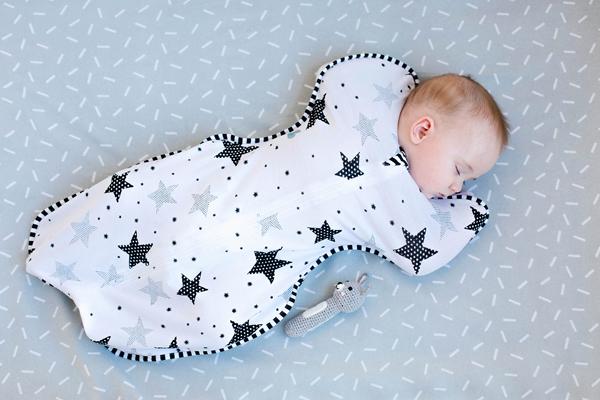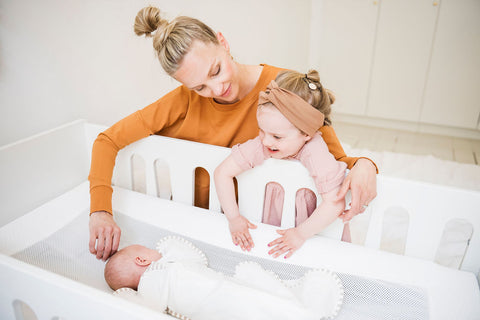Baby needs a sense of security and something warm in order to sleep well. The right temperature of the baby’s body and optimal sleep environment are a prerequisite for good sleep. Because the little ones are individuals with different sleep habits and predilections, you should try different blanket and sleeping bag options in an unprejudiced manner.
We listed pros and cons of the different baby sleep essentials which will help you to choose the right ones for your baby.
Blankets
Most of the Finnish babies sleep their first year with the blanket you get from the maternity package. On the other hand, some families want to follow traditions: the same hand crocheted blanket can be passed on from one generation to the next.
Pros and cons:
+ The blanket is open from its sides, so it allows air flow
+ Your baby can move his hands and legs under the blanket (can make falling asleep harder though)
- Your baby can kick off the cover and wake up to coldness
- The blanket can cover your baby’s head and at least in theory be a risk factor for SIDS
The maternity package’s blanket is very light and airy. There are no SIDS cases because of that blanket in Finland. However, if your baby likes to pull the blanket, some other option can be considered for example a sleeping bag.
Sleeping bags
The sleeping bag, as its name suggest, is closed across the bottom, which will not fall off because of the fabric suspenders. Especially in Central Europe the sleeping bags are replacing blankets.
Using the sleeping bag and swaddle simultaneously with the Lullame self-rocking baby mattress is the ideal option: you don’t need any top sheet on the mattress. You can easily remove the fabric and wash it in 60 degrees.
Pros and cons:
+ It will cover your baby even though he/she is an active sleeper
+ It won’t cover your baby’s face in any case
+ You don’t need any separate sheets
+ It prevents that your baby’s arms and legs won’t stick through the crib sides
- It can be hard to use it, when your baby starts to try standing up
- Sleeping bag, which are made from synthetic materials, (i.e. polar fleece) can be sweaty
- Sleeveless versions don’t cover your baby’s shoulders or arms
You should pay extra attention to the material of the sleeping bag!
Swaddles
Parents have swaddled babies for millenniums. The oldest references to swaddling are dating as far back as 4000 BC. Now swaddles are making a comeback in a modern version. Many families, who don’t sleep well, have been pleasantly surprised by the soothing effect of the swaddling – the little one sleeps calmly in a swaddle like a baby kangaroo in her mother's pouch.
Pros and cons:
+ A swaddle reminds the baby of the womb-like conditions
+ When babies are swaddled, they can’t startle themselves to awake with their Moro reflex
+ Night feeds are possible so that your baby won’t get refreshed in the cool air
+ Swaddling is very helpful with babies with colic or reflux
- Swaddling in the right way requires practicing and it can be hard to find the right tightness for your baby
- Your baby may get too hot in a traditional swaddle
These modern time, baggy swaddles don’t require knowing how to swaddle, because they often have stickers or zippers. The breathability is also better, because you don’t wrap a blanket around your baby, like you’re doing when swaddling in a traditional way.
Love to Swaddle UP™ is a modern version of an age-old swaddle cloth. Baby's arms stay in a natural position where baby can bring his fingers to his mouth if needed. However, that swaddle prevents sudden movements which are often the reason why your baby wakes up in the middle of the night. You can open the swaddle from the bottom for diaper changing.
The swaddling won’t replace the need of the parent-child closeness. It only makes the falling asleep and sleeping itself easier. Your baby should be enjoying physical contact and moving around freely when awake.
Other sleep equipment
The baby’s crib should be due to safety and hygiene reasons as "empty" as possible: that means no cute stuffed animals, blankets, or nursing pillows. One light and safe blankie or lovey is enough. You shouldn’t leave any towels, clothes, or sheets to the edge of your baby’s bed, because those are a huge risk factor for SIDS if they fall into the crib.
One-year-old and younger babies don’t need a pillow! Many of the babies don’t need it at all before turning 2 years. Using pillows with small babies are linked to SIDS.
Bumber pads prevents child's arms and legs sticking through the crib sides. The pads must be fastened with care and you should check those fasteners always when you change the sheets.
Babynest is an extra bed with padded sides, which will be placed to baby’s bed. It is intended to delimit, for example, in a crib a safe, small area for a sleeping baby. Homemade sleep nest involves a risk: is it made in a right way or are the materials safe for babies?
Crib canopy darkens and protects the baby’s crib. Make sure that the tiny hands can’t reach the fabric above the bed.
Sheets need to be tucked in firmly, so that they can't come loose!
You don’t need any sheets when using the Lullame self-rocking baby mattress: the washable and breathable fabric lets air through even though your baby can lie on her stomach. However, this doesn’t work if you use separate sheets. We recommend always placing your baby on his/her back.
Sanna K.
The writer is a biologist, who is continually searching for better sleep! She has a baby who didn’t used to sleep well.





Leave a comment: